#Continental Mark II Convertible
Explore tagged Tumblr posts
Text



Continental Mark II Convertible, 1956, by Hess & Eisenhardt. The Mark II Continental was the most expensive domestically produced automobile sold in the United States in its day, costing the equivalent of $116,980 (base price in 1956 was $9,966). It was only ever left the factory as a 2-door hardtop. Two cars were modified into convertibles by coachbuilders commissioned by Ford but the convertible Mark II was never offered to the public. The Mark II was launched when Continental was a stand-alone sub-brand, however in July 1956 Ford closed the Continental Division, integrating Continental into Lincoln.
#Continental#Continental Mark II#Continental Mark II Convertible#Lincoln Continental#1956#coachbuilt#Hess & Eisenhardt#dead brands#open roof#1950s
219 notes
·
View notes
Text

1956 Continental Mark II Convertible
#Continental Mark II Convertible#Continental Mark II#Continental#lincoln continental#convertible#car#cars
196 notes
·
View notes
Photo



Continental Mark II Convertible by Derham 1956. - source Amazing Classic Cars.
108 notes
·
View notes
Video
youtube
Charles Phoenix JOYRIDE - 1956 Continental Mark II Convertible
1 note
·
View note
Photo

On January 19, 1978, the last Volkswagen Beetle made in Germany leaves VW's plant in Emden. Production of the Beetle continued in smaller numbers at other German factories until 19 January 1978, when mainstream production shifted to Brazil and Mexico: markets where low operating cost was an important factor. After this shift in production, sales in Europe did not stop, but became very low. Beetle sedans were produced for U.S. markets until July 1977 and for European markets until 1985, with other companies continuing to import cars produced in Mexico after 1985. The Beetle convertible/Cabriolet ended production (as 1979 models) on 31 January 1980.
The Volkswagen Beetle—officially the Volkswagen Type 1, informally in German the Käfer (meaning "beetle"), in parts of the English-speaking world the Bug, and known by many other nicknames in other languages—is a two-door, rear-engine economy car, intended for five occupants (later, Beetles were restricted to four people in some countries), that was manufactured and marketed by German automaker Volkswagen (VW) from 1938 until 2003.
The need for a people's car (Volkswagen in German, and in the English-speaking world in the early 20th century as "folks' wagon"), its concept and its functional objectives were formulated by the leader of Nazi Germany, Adolf Hitler, who wanted a cheap, simple car to be mass-produced for his country's new road network (Reichsautobahn). Members of the National Socialist party, with an additional dues surcharge, were promised the first production, but civil war in Spain shifted most production resources to military vehicles instead to support Francisco Franco. Lead engineer Ferdinand Porsche and his team took until 1938 to finalise the design. Béla Barényi is credited with first conceiving the original design for this car in 1925, notably by Mercedes-Benz, on their website, including his original technical drawing, five years before Porsche claimed to have done his initial version. The influence on Porsche's design of other contemporary cars, such as the Tatra V570, and the work of Josef Ganz remains a subject of dispute. The result was the first Volkswagen, and one of the first rear-engined cars since the Brass Era. With 21,529,464 produced, the Beetle is the longest-running and most-manufactured car of a single platform ever made.
Although designed in the 1930s, due to World War II, civilian Beetles only began to be produced in significant numbers by the end of the 1940s. The car was then internally designated the Volkswagen Type 1, and marketed simply as the Volkswagen. Later models were designated Volkswagen 1200, 1300, 1500, 1302, or 1303, the former three indicating engine displacement, the latter two derived from the model number. The car became widely known in its home country as the Käfer (German for "beetle", cognate with English chafer) and was later marketed under that name in Germany, and as the Volkswagen in other countries. For example, in France it was known as the Coccinelle (French for ladybug). In 1943, Roy Fedden applied for a patent, GB570814, 'Improvements relating to road vehicles', a car identical to VW Käfer.
The original 25 hp Beetle was designed for a top speed around 100 km/h (62 mph), which would be a viable cruising speed on the Reichsautobahn system. As Autobahn speeds increased in the postwar years, its output was boosted to 36, then 40 hp, the configuration that lasted through 1966 and became the "classic" Volkswagen motor. The Beetle gave rise to multiple variants: mainly the 1950 Type 2 'Bus', the 1955 Karmann Ghia, as well as the 1961 Type 3 'Ponton' and the 1968 Type 4 (411/412) family cars, ultimately forming the basis of an entirely rear-engined VW product range. The Beetle thus marked a significant trend, led by Volkswagen, and then by Fiat and Renault, whereby the rear-engine, rear-wheel-drive layout increased from 2.6 percent of continental Western Europe's car production in 1946 to 26.6 percent in 1956. In 1959 even General Motors launched an air-cooled, rear-engined car, the Chevrolet Corvair—which even shared the Beetle's flat engine and swing axle architecture.
Over time, front-wheel drive, and frequently hatchback-bodied cars would come to dominate the European small-car market. In 1974, Volkswagen's own front-wheel drive Golf hatchback succeeded the Beetle. In 1994, Volkswagen unveiled the Concept One, a "retro"-themed concept car with a resemblance to the original Beetle, and in 1998 introduced the "New Beetle", built on the contemporary Golf platform with styling recalling the original Type 1. It remained in production through 2010, and was succeeded in 2011 by the Beetle (A5), the last variant of the Beetle, which was also more reminiscent of the original Beetle. Production ceased altogether by 2019.
In the 1999 Car of the Century competition, to determine the world's most influential car in the 20th century, the Type 1 came fourth, after the Ford Model T, the Mini, and the Citroën DS.
By 2002, over 21 million Type 1s had been produced, but by 2003, annual production had dropped to 30,000 from a peak of 1.3 million in 1971. VW announced the end of production in June 2003, citing decreasing demand, and the final original Type 1 VW Beetle (No. 21,529,464) rolled off the production line at Puebla, Mexico, on 30 July 2003, 65 years after its original launch. This last Beetle, nicknamed El Rey (Spanish for "The King" after a legendary Mexican song by José Alfredo Jiménez) was delivered to the company's museum in Wolfsburg, Germany.
To celebrate the occasion, Volkswagen marketed a final, special series of 3,000 Beetles marketed as "Última Edición" (Final Edition) in light blue (Aquarius Blue) or beige (Harvest Moon Beige). Each car included the 1.6 engine, whitewall tires, a CD player with four speakers, chrome bumpers, trim, hub caps and exterior mirrors, a Wolfsburg emblem above the front trunk's handle, an all-cloth interior, chrome glove box badge, body coloured wheels, tinted glass, a rear parcel shelf, and VW Última Edición plaque.
A mariachi band serenaded production of the last car. In Mexico, there was an advertising campaign as a goodbye for the Beetle. In one of the ads was a very small parking space on the street, and many big cars tried to use it, but could not. After a while, a sign appears in that parking space saying: "Es increíble que un auto tan pequeño deje un vacío tan grande" (It is incredible that a car so small can leave such a large void). Another depicted the rear end of a 1954 Beetle (the year Volkswagen was established in Mexico) in the left side of the ad, reading "Erase una vez..." (Once upon a time...) and the last 2003 Beetle in the right side, reading "Fin" (The end). Other ads also had the same nostalgic tone.
List of names for the Volkswagen Type 1
The Volkswagen Type 1 automobile, also known as the Volkswagen Beetle or Bug, is known colloquially by various names in different countries, usually local renderings of the word "beetle". Among these are:
Bintus, Ijapa, Mbe, or Tortoise Car in Nigeria
Beetle in the UK, and in many English speaking Commonwealth countries (e.g. Australia & New Zealand)
Bug or Beetle-Bug in the US
Käfer (beetle) in Germany, Austria and Alemannic Switzerland
Kever in Dutch-speaking Belgium and the Netherlands
Pichirilo in Ecuador and Colombia
Pulga (flea), Escarabajo (beetle) in Colombia
ඉබ්බා (tortoise) in Sri Lanka
Vocho, Vochito or Volcho (navel) in Mexico, Costa Rica, Colombia and Perú
Fusca in Brazil, Paraguay and Uruguay (from "fauvê", "VW" in German pronunciation), Fusquinha (little VW) in Brazil, Fusquita (little VW) in Uruguay
Escarabajo (beetle) in Argentina, Chile, Colombia, Paraguay, Perú, Spain, Uruguay, El Salvador, Costa Rica and Venezuela
Sapito (little toad) in Perú
Peta (turtle) in Bolivia
Folcika or Buba (bug) in Bosnia and Herzegovina
Косτенурка ("Kostenurka", turtle), Бръмбар ("Brambar", beetle) in Bulgaria
Bug, Beetle in Australia, English Canada, India, the United Kingdom, and the United States
Escarabat (beetle) in Catalan
Poncho in Chile
甲壳虫 ("Jiǎ Ké Chóng", beetle) in China
Buba in Croatia
Brouk in Czech Republic
Boblen (The bubble), Bobbelfolkevogn (bubble Volkswagen), Asfaltboblen (The asphalt bubble), Billen (The Beetle) gravid rulleskøjte (pregnant rollerskate) or Hitlerslæden (Hitler-sled) in Denmark
Cepillo (brush or ice shaver) in Dominican Republic
خنفسة ("khon-fesa", beetle) in Egypt
Fakrouna (tortoise) in Libya
Põrnikas (beetle) in Estonia
Kupla (bubble), Kuplavolkkari (bubble Volkswagen), Aatun kosto (Adi's revenge) in Finland
Coccinelle (ladybug) in France, French-speaking Belgium and Switzerland, Algeria, Quebec and Haiti
Choupette (Herbie's name in the French version of the movie) in French Canada
Буба (beetle) in North Macedonia
金龜車 ("Jin-guei che") in Taiwan
Σκαθάρι ("Skathari", beetle), Σκαραβαίος ("Skaraveos", scarab), Χελώνα ("Chelona", turtle), Κατσαριδάκι ("Katsaridaki", little cockroach) in Greece
Cucaracha or Cucarachita (cockroach, little cockroach) in Guatemala, El Salvador and Honduras
Bogár (beetle) or bogárhátú (beetle-back) in Hungary
Bjalla (beetle) in Iceland
Kodok (frog) in Indonesia
Ghoorbaghei (قورباغه ای) (frog) in Iran
Agroga عكروكة (little frog), Rag-gah ركـّة (little turtle) in Iraq
חיפושית ("Hipushit", beetle) or Bimba in Israel
Maggiolino (maybug, cockchafer), Maggiolone (big beetle) in Italy
ビートル ("Bītoru", beetle) in Japan
Kifuu in Kenya
Vabole in Latvia
Vabalas in Lithuania
Kura (turtle), Kodok (frog) in Malaysia
Sedán (sedan car), Pulguita (little flea), Vocho/Vochito or Bocho/Bochito (little Volkswagen) in Mexico and across Latin America
Kashima in Namibia
Bhyagute car (frog car) in Nepal
Boble (bubble) in Norway
Foxi or Foxy in Pakistan
Pendong, Kotseng kuba (hunchback car), Pagong, Ba-o, (turtle), Boks (tin can), sometimes Beetle in the Philippines
Garbus (hunchback) in Poland
Carocha (beetle) in Portugal
Volky in Puerto Rico
Broasca, Broscuţă (little frog), Buburuza (ladybird) in Romania
Фольксваген-жук ("Folksvagen-zhuk", Volkswagen bug) in Ukraine
Жук ("Zhuk", beetle) in Russia
Буба ("Buba", bug) in Serbia
Volla or Volksie (little Volkswagen), Kewer (beetle) in South Africa
Chrobák (beetle) in Slovakia
Hrošč (beetle) in Slovenia
Volks, Beetle or Ibba (turtle) in Sri Lanka
Mgongo wa Chura (frog's back), Mwendo wa Kobe (tortoise speed) in Swahili
Folka (Volkswagen), Bagge (short for Skalbagge, beetle), Bubbla (bubble) in Sweden and Swedish-speaking Finland
Mgongo wa Chura in Tanzania
รถเต่า ("Rod Tao", turtle car), โฟล์คเต่า ("Volk Tao", Volkswagen turtle) in Thai
Kaplumbağa (turtle), Tosbağa (tortoise), Vosvos in Turkey
Con Bọ in Vietnam
Bhamba datya ("Datya", frog) in Zimbabwe
Tortuga (tortoise) in Panama
Цох in Mongolia
"فولوکس" ("Foloks", philosopher), in Afghanistan
Buba in Montenegro
Super Beetle in North America
Super Bug in North America
Banju Maqlub (literally, a bathtub turned upside down) in Malta
* Photo Above: "Última Edición" (Final Edition) in Aquarius Blue (2003)
Daily inspiration. Discover more photos at http://justforbooks.tumblr.com
20 notes
·
View notes
Photo

1956 Lincoln Continental Mark II Convertible - clean lines.
128 notes
·
View notes
Photo

1956 Continental Mark II Convertible. One of 16 in the world. #MarkII #Continental #RareCar #VintageCar #LuxuryCar #AntiqueCar #FoMoCo #CarsOfInstagram #BucketList #Convertible #OldSchool
#continental#vintagecar#antiquecar#bucketlist#convertible#markii#rarecar#luxurycar#oldschool#fomoco#carsofinstagram
1 note
·
View note
Photo

Reposted from @mecum_auctions (@get_regrann) - Keep those Sold Stickers coming! ... This 1956 Continental Mark II Convertible sold for a hammer price of $85,000. ... #MecumVegas #Vegas #Mecum #MecumAuctions #WhereTheCarsAre - #regrann https://www.instagram.com/p/B3hcQnOlISe/?igshid=1xrbyznl1wwv7
0 notes
Text
Lincoln Continental Mark V: Country Club Living
This is what to drive to Bushwood for dinner and dancing. Gratuitous length, overwrought styling to hide the LTD II underpinnings, and a price that says none of those criticisms matter.
This is also the car that introduced the "carriage roof." Vinyl, even padded vinyl, was for ordinary mortals. This hardtop came with faux bows and yards of canvas over them to simulate a convertible top.
It was a valiant effort to mix the knife edge fenders with the 5 mph bumpers. By contemporary standards, that integration hasn't aged quite as well as the mostly useless, form-fitting bumpers of the 1960s
1 note
·
View note
Photo



Lincoln Continental Mark II Convertible by Hess & Eisenhardt, 1956. The Mark II Continental only ever left the factory as a 2-door hardtop coupé but 2 prototype convertibles were made as well as the one by Hess & Eisenhardt. As Ford were already losing $1000 on every Mark II they sold the chances and losing even more on a convertible must have put them off.
pics by Kevin Pearce
#Lincoln#Lincoln Continental Mark II#Lincoln Continental#Lincoln Continental Mark II Convertible#Hess & Eisenhardt#coachbuilt#convertible#1956#1950s#Lincoln-Mercury Division
267 notes
·
View notes
Text

1960 Lincoln Continental Mark V Landau

1960 Lincoln Continental Mark V Landau

1960 Lincoln Continental Mark V Landau
At the time the Lincoln was one of the biggest cars ever made.
The 1958–1960 Lincolns and Lincoln Continentals were the most massive American passenger cars produced since World War II, as they were built on a 131-inch wheelbase and had an overall length of 229 inches. The Mark III Convertible tips the scales at an impressive 4,928 pounds, and only 3,048 were produced.
The design is typically credited to John Najjar, although a junior designer named Larry Shinoda, later famed for his work on the 1963 Corvette Stingray, contributed to the design. The Lincolns were built at Ford Motor Company’s Wixom, Michigan, plant, together with the second-generation Thunderbirds, and they were Ford Motor Company’s first unibody automobiles.
#Lincoln Continental Mark V Landau#Lincoln Continental Mark V#lincoln continental#Lincoln#Continental Mark V#continental#car#cars#ford
288 notes
·
View notes
Photo
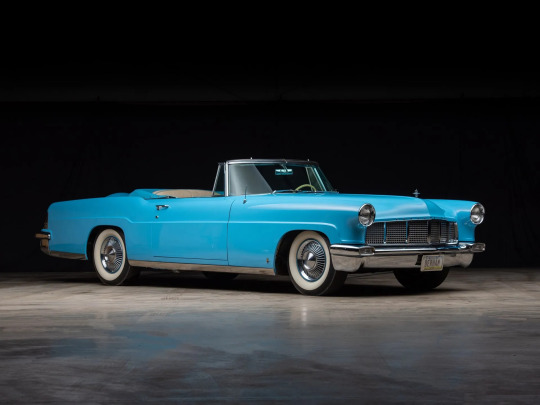
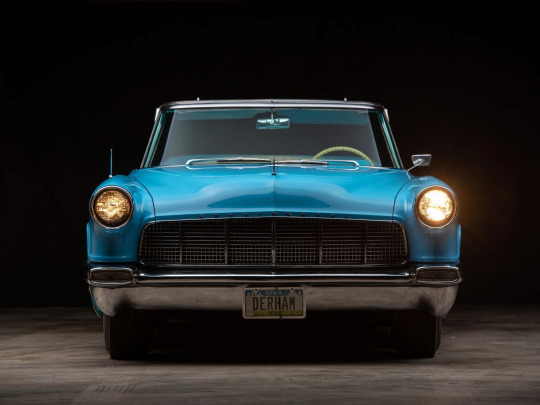
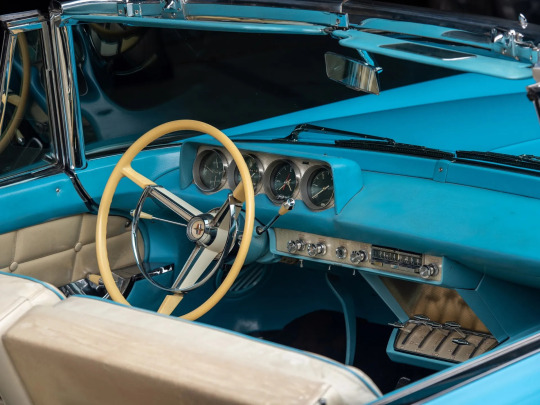
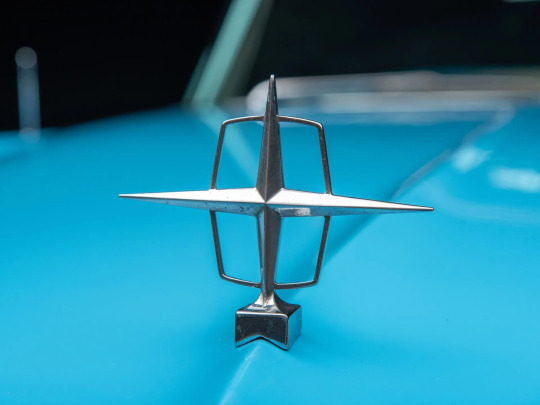
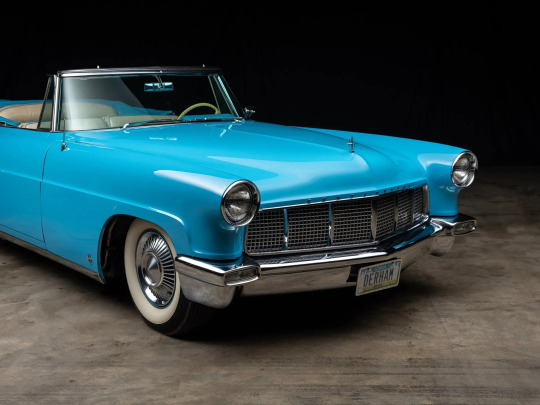
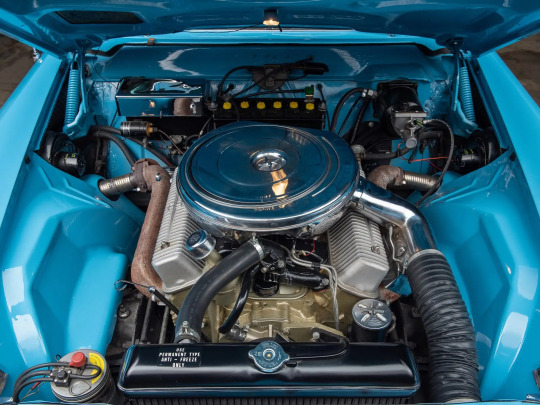
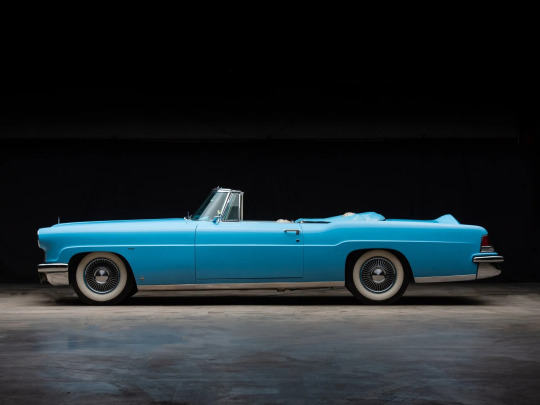
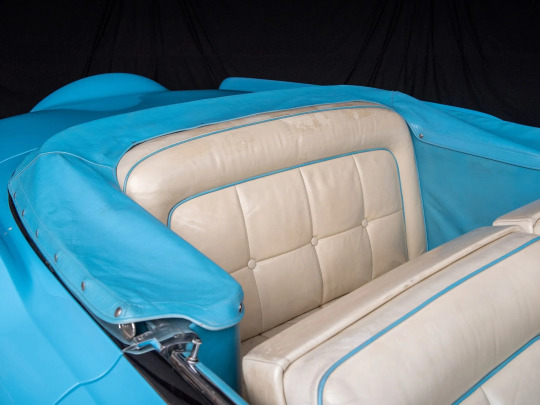
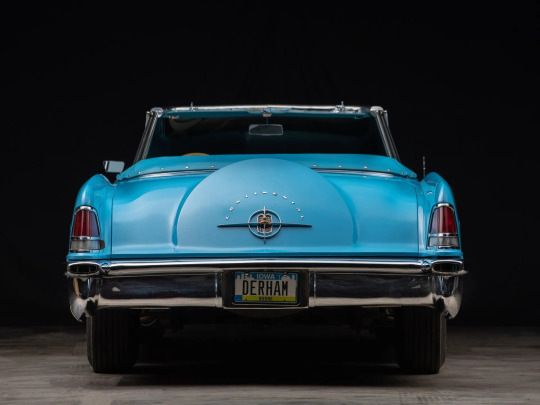

Continental Mark II Convertible by Derham 1956. - source RM Sotheby’s.
196 notes
·
View notes
Link
Many Americans feared that the end of World War II and the subsequent drop in military spending might bring back the hard times of the Great Depression. But instead, pent-up consumer demandfueled exceptionally strong economic growth in the post-war period. The automobile industry successfully converted back to producing cars, and new industries such as aviation and electronics grew by leaps and bounds.
A housing boom, stimulated in part by easily affordable mortgages for returning members of the military, added to the expansion. The nation's gross national productrose from about $200,000 million in 1940 to $300,000 million in 1950 and to more than $500,000 million in 1960. At the same time, the jump in post-war births, known as the "baby boom," increased the number of consumers. More and more Americans joined the middle class.
THE MILITARY INDUSTRIAL COMPLEX
The need to produce war supplies had given rise to a huge military-industrial complex (a term coined by Dwight D. Eisenhower, who served as the U.S. president from 1953 through 1961). It did not disappear with the war's end. As the Iron Curtain descended across Europe and the United States found itself embroiled in a cold war with the Soviet Union, the government maintained substantial fighting capacity and invested in sophisticated weapons such as the hydrogen bomb.
Economic aid flowed to war-ravaged European countries under the Marshall Plan, which also helped maintain markets for numerous U.S. goods. And the government itself recognized its central role in economic affairs. The Employment Act of 1946 stated as government policy "to promote maximum employment, production, and purchasing power."
The United States also recognized during the post-war period the need to restructure international monetary arrangements, spearheading the creation of the International Monetary Fund and the World Bank -- institutions designed to ensure an open, capitalist international economy.
Business, meanwhile, entered a period marked by consolidation. Firms merged to create huge, diversified conglomerates. International Telephone and Telegraph, for instance, bought Sheraton Hotels, Continental Banking, Hartford Fire Insurance, Avis Rent-a-Car, and other companies.
CHANGES IN THE AMERICAN WORKFORCE
The American workforce also changed significantly. During the 1950s, the number of workers providing services grew until it equaled and then surpassed the number who produced goods. And by 1956, a majority of U.S. workers held white-collar rather than blue-collar jobs. At the same time, labor unions won long-term employment contracts and other benefits for their members.
Farmers, on the other hand, faced tough times. Gains in productivity led to agricultural overproduction, as farming became a big business. Small family farms found it increasingly difficult to compete, and more and more farmers left the land.
As a result, the number of people employed in the farm sector, which in 1947 stood at 7.9 million, began a continuing decline; by 1998, U.S. farms employed only 3.4 million people.
Other Americans moved, too. Growing demand for single-family homes and the widespread ownership of cars led many Americans to migrate from central cities to suburbs. Coupled with technological innovations such as the invention of air conditioning, the migration spurred the development of "Sun Belt" cities such as Houston, Atlanta, Miami, and Phoenix in the southern and southwestern states. As new, federally-sponsored highways created better access to the suburbs, business patterns began to change as well. Shopping centers multiplied, rising from eight at the end of World War II to 3,840 in 1960. Many industries soon followed, leaving cities for less crowded sites.
---
See: Years of Change: The 1960s and 1970s
This article is adapted from the book "Outline of the U.S. Economy" by Conte and Carr and has been adapted with permission from the U.S. Department of State.
0 notes
Text
Bentley has announced the Continental GT Convertible Number 1 Edition by Mulliner as part of a tribute to the 1929 Bentley Blower race car. Production of the special model is limited to just 100 units, each featuring 18-carat gold plated fender badging, as well as a gold plated number one set within the Rotating Display.
Colour-wise it’s available in Dragon Red II or Beluga, complete with a Claret or Beluga folding hood (which deploys or retracts in 19 seconds). The Limited Edition is equipped with a Centenary Pack, Bentley Black Line Specification and Carbon Body Kit, rounded off by the painted Number 1 front grille.
The Centenary Pack comes with LED welcome lamps, Centenary badges to the rear, wheel caps, gear lever, steering wheel, and key fob. Other finishing touches include jewelled filler and oil caps, as well as 22-inch MD wheels finished in Cricket Ball or Gloss Black.
Inside, the cabin gets a two-tone finish of either Cricket Ball or Beluga, complemented by Heritage hide on the seats and door pads, with a debased B insignia on the head restraints and/or inserts. The Grand Black wood veneer is enhanced by 18 carat gold plated organ stops and an Alcantara steering wheel and gear lever. A Number 1 tread plate insert is standard, too.
Within the Bentley Rotating Display, a small wheel spinner has been set in resin, seamlessly merging the best of design both present and past. Each wheel spinner has been cast from a piston from the No. 1, taken during restoration work.
Unchanged from before is the powertrain. Here, it gets the 6.0 litre twin-turbocharged W12 TSI engine that produces 626 hp at 6,000 rpm and 900 Nm from 1,350 rpm to 4,500 rpm. It does the 0-100 km/h run in 3.8 seconds before maxing out at 333 km/h. An eight-speed dual-clutch transmission is standard.
With that, the introduction of the Number 1 Edition marks the final car in Bentley’s Centenary trilogy. Like the Mulsanne W.O. Edition and the Continental GT Number 9 Edition, it incorporates a unique piece of Bentley history.
The creation of the model was inspired by the No. 1 Blower, which set the Outer Circuit record at the Brooklands racetrack, Surrey, in 1932. The car, which was powered by a 4.5 litre engine that averaged 220 km/h (a record that stood for two years and has since become a symbol of Bentley’s racing heritage), was driven by Bentley Boy Tim Birkin.
The No. 1 Blower was born through a combination of Birkin’s skillset and the financial backing of wealthy horse racing enthusiast, Dorothy Paget. When Bentley stopped backing Birkin’s project, Paget saw the potential of the car and stepped in to help.
Birkin’s modified Bentley used a supercharger to increase the pressure of air to the engine, creating more power. Described as ‘blowing’ air into the engine, it resulted in the Birkin car being referred to as the Bentley Blower. What do you think of this?
Bentley Continental GT Convertible Number 1 Edition by Mulliner debuts – 6.0L W12 beast, 100 units only! Bentley has announced the Continental GT Convertible Number 1 Edition by Mulliner as part of a tribute to the 1929 Bentley Blower race car.
0 notes
Text
The 19th Annual PPG Syracuse Nationals
There’s just something magical about the sound of a hopped-up V-8 to raise your adrenalin level. Couple this with the chance to hit the open road during the summer months and the combination is endless for the potential trips you could take. Regardless of whether it’s to a local cruise night, a highway run to simply knock off some miles, or planning a trip to a national event, one thing for sure is that seat time in your hot rod or custom makes the journey extra special. Pulling into town to check into a large event raises the cool factor to the highest level.
Wayne Earle | 1951 Chevy | Gasburg, VA There’s something cool about a lowered Chevy custom that commands your attention. Kentz Kustomz set the stance and added just the right amount of allure, including frenched headlights and a custom grille with power coming from a warmed-over 350ci Chevy mill. The PPG Sun Kiss coating and panel-painted roof completes the look.
This year’s PPG Syracuse Nationals celebrated its 19th anniversary as one of the largest rodding events on the East Coast. If you dig hot rods, customs, classic trucks, muscles cars, restos, and race cars the assemblage of horsepower on this three-day weekend festival was enough to leave you breathless. Visually you were greeted at every corner by a virtual kaleidoscope of candy-coated colors, giving you a perfect base to see just where the weekend would take you.
Randy Weaver | 1931 Ford | Sandy, UT Chopped, channeled, and laced with attitude, this Model A packed a healthy dose of venom thanks to the team at Weaver Customs. Sitting on a custom chassis complete with a Heidts IFS, it showcased a 401ci Ford V-8 with twin-turbos rolling on wheels from Detroit Steel. The subtle Axalta Sand Bronze vibe added a level of classic elegance.
After checking in to get your credentials, a cruise over to the pristine New York State Fairgrounds sets the stage for the event as it unfolds across well over 365 acres. The massive facility is like stepping back in time as you motor through countless tree-lined streets flanked by numerous classic buildings as well as horse and livestock barns. When the need to feed hits you have an endless stream of choices, thanks to old-time eateries across the grounds, offering plenty of choices to bring back memories from when you were a youngster. Once settled it’s easy to head out and weave through literally thousands of cars and trucks as well as check out all of the vendors showcasing the latest cool parts for your ride.
Rick Bolea | 1933 Ford | Moon Township, PA Rick’s coupe is pure hot rod. Completed by Precision Hot Rods & Fabrication, the body features a perfectly balanced chop accented by a custom hood top and sides along with immaculate PPG Red Mahogany gloss. Power comes from a dual-quad-fed 427ci Ford FE V-8 with Real Rodders wheels wrapped with BFGoodrich tires to plant the power.
There were numerous scheduled tech seminars from industry leaders, including PPG, Inland Empire, LEED Brakes, and Morrisville State College to guide you through a number of topics. New this year was a Pro Builders Panel presented by Ingersoll Rand, which was an open forum moderated by Jerry Dixey of STREET RODDER for participants to ask questions of builders Dave Tucci, Dom Tucci, Chris Ryan, Rob Ida, and Jeremy Baye, which was a great success. The Tucci Hot Rods Pro Pick area was once again packed with participants as live bands performed on numerous stages throughout the fairgrounds, all wrapped up by nightly fireworks displays.
Tom Cochran | 1955 Chevy | Wilmington, DE The designers at Chevrolet hit a home run with the Nomad. Bringing it to the next level starts with a bitchin stance from a custom IFS and rear suspension linked to Nitto tires on big-inch Ridler wheels powered by an LT1 V-8. A custom interior by Lucky 7 was accented by a flawless body wearing BASF Lamborghini orange and white pearl.
But wait there’s more, as the Old-Skool Roundup located in a separate open-air pavilion is a show-within-a-show featuring a wicked grouping of traditional hot rods and customs accented by a vintage swap meet and razor-sharp Rockabilly bands. Race car fans could check out Gasoline Alley where classic array of Funny Cars, Gassers, Bonneville racers, and more celebrated history. Competition this year for the Winfield Award among the Select Six presented by custom car legend Gene Winfield was exhilarating, with the win going to Chris Ryan or Ryan’s Rod & Kustom for his decadent 1956 Lincoln Continental Mark II known as “The Scarlet Lady.” Artie’s Party Pinstriping and Panel Jam to benefit The Ronald McDonald House Charities of Central New York has become legendary with custom designed artwork auctioned throughout the weekend.
Preston Carden Jr. | 1956 Chevy | Newcastle, DE Gassers are the ultimate statement, especially when they’re set up like Carden’s. A Speedway Motors suspension gave it the right-on stance with a Borla Induction stack-injected 421ci mill linked to a TREMEC five-speed adding go. Halibrand wheels and Firestone rubber are cool while a PPG shine and a classic bench interior finishes it.
Once Sunday arrived it was time for the Syracuse Nationals giveaway program showcasing the Garage Gear Giveaway to one lucky participant. By the time the weekend came to a close over 8,200 cars had motored across the pavement along with 95,000 visitors. With the support of the Central New York Car Club Association (the hosts of the show) and area service clubs, donations were made from proceeds of the event in the amount of $20,000 plus $68,000 from the Panel Jam auctions to a number of local charities plus additional donations, bringing the yearly total to $95,000. This brought the 19-year donation total to $1.4 million. As this event continues to grow with each passing year we can’t wait to check it out again in 2019 for the 20th anniversary. You can see more at rightcoastcars.com.
Dave & Sue Ciappa | 1955 Chevy | Lockport, NY If you want to haul with style look no further. A subtle chop is accented by a lustrous coating of Axalta platinum and pearl white combined with RideTech ’bags and Schott wheels on Michelin rubber. A Chevy 406ci V-8 brings power and Wilwood brakes add stopping power. Inside Vintage Air and Classic Instruments track the cooling and vitals.
Lisa Wilsey | 1933 Ford | Whitesboro, NY Roadsters in the summertime personify hot rodding. Tucci Hot Rods nailed it with this drop-top packing a hopped-up small-block linked to a 700-R4 trans to spin 17- and 20-inch Dodge Nitro rims topped with Coker tires. PPG Deep Sea Metallic brings it to life, accented by tan vinyl and custom interior panels by Dom Tucci Design.
Gary Corkell | 1932 Ford | Middletown, DE Built in 10 weeks by One-Off Rod & Custom, this Deuce started with a body and chassis combination from Adams Hot Rod Shop. It was treated to a searing 357ci V-8 topped with a sextet Speedway Motors 9Super7 carbs linked to a TH350 trans. Coated in custom PPG Blue Sugar it rolls on Wheel Vintiques wheels and Coker/Firestone rubber.
Gef Freese | 1954 Ford | Pittsfield, NH To set a wicked stance, Traditional Speed and Custom incorporated an Art Morrison chassis with IFS and a Winters quick-change out back. Power comes from a Roush 427ci IR crate engine topped with stack injection linked to a TREMEC T56 trans. Coated in Nason red it rolls on Vintage wheels and features a Petter Davidsen full leather interior.
Derrick & Katie Pesko | 1927 Ford | Waterford, CT Injecting a neat ’60s vibe this T sets the pace with a refreshing PPG white body accented with ice blue lines. Built by Allstar Hot Rods it features their signature chassis with a Speedway Motors 5-inch dropped front axle and GM 10-bolt rear. A 350ci V-8 adds power and inside shortened 1952 Olds dash, bomber seats, and fur carpet look awesome.
Best Ford in a Ford Bob Casey’s 1954 Ford Sunliner
While honoring the 19th Syracuse Nationals it was a perfect time for STREET RODDER and Ford Performance to recognize street rodders who install a late-model Ford engine in a Ford hot rod or custom. While canvassing the massive confines of the New York State Fairgrounds we found Bob Casey’s immaculate 1954 Ford Sunliner featuring a Ford Performance 351ci Windsor crate V-8, which caught our immediate attention.
It’s easy to see that Bob was destined to follow an automotive path since his influences were sparked when he first saw the family’s new 1949 Mercury parked in the garage. The car was bigger than life and although he needed a stepstool to see into the engine bay his fascination with its mechanical components fueled a passion. Following the path it wasn’t long till he graduated to customizing kit models at the kitchen table fueled by the latest issues of Hot Rod magazine and regular visits to local car dealerships to check out the newest models in person. Without a doubt the latest offerings from Ford and Mercury stood tall over all other manufacturers in his eyes.
Studying the latest creations by George Barris and watching 77 Sunset Strip to see the Kookie Car cruise the strip translated perfectly when he was able to help his cousin Jake nose and deck his 1947 Ford business coupe one summer. He eventually earned his driver’s license and the keys to a 1959 Ford Galaxie convertible with many more cool rides to follow, including a number of Ford hot rods and customs. Never forgetting his passion for ’50s-era Ford convertibles he eventually started searching for a suitable base to start with for his latest build. His quest led him to a 1954 Ford Sunliner in Illinois, which presented itself in pictures to be a nice solid driver. A deal was made and Bob had the car shipped to Ray Bartlett, co-owner of The East Coast Hot Rod Garage in Denton, Maryland, for evaluation. Since the car was going to be a full build, the team began disassembly, which led to the truth that the car had see far better days as it was riddled with hidden prior accident damage and an ample amount of rust. A plan was made to overcome the issues and start the build of a classic mild custom.
For a rock-solid base a call was made to Art Morrison for one of their Max G chassis featuring a mandrel-formed 2×4-inch fixture-welded frame. Out back a Ford 9-inch rear was packed with 3.50:1 gears spinning by Strange Engineering axles and suspended in place by a triangulated four-bar along with a matching antiroll bar and RideTech coilover shocks. Up front an exclusive Art Morrison IFS featuring their tubular steel control arms with matching spindles and antiroll bar combined with RideTech coilover shocks links to power rack-and-pinion steering. To add plenty of stopping power a Wilwood dual master pushes fluid through stainless lines to matching 12-inch drilled and vented discs and calipers anchored at each corner. Linking it all to the street are a set of classic 15-inch chrome reverse from Wheel Vintiques capped with wide whites from Diamond Back.
Wanting to maintain tradition and keep Ford power in his Sunliner, Bob went to Ford Performance Parts and selected their 351ci Windsor crate V-8 packed with 385 hp. The engine features a nodular iron crank linked to Ford rods wearing forged aluminum pistons urged by a factory cam. Up top plenty of seamless power comes from a pair of GT-40 aluminum cylinder heads perfectly matched to an Edelbrock intake capped with a matching 650-cfm carb wearing a 14-inch chrome air cleaner. An MSD ignition lights the fire with spent gases dumping though Sanderson headers to a custom 2-1/2-inch stainless exhaust with Flowmaster Series 50 mufflers. Neat details include a Billet Specialties Tru-Trac drive system along with Ford Racing valve covers. Custom touches to give the engine bay plenty of allure include a hand-fabricated firewall, radiator support, inner fenders panels, and radiator cover by team member Dale Rhodes. A Ford 4R70W trans massaged by Performance Automatics of Frederick, Maryland, moves the power to a custom steel driveshaft.
Bringing the weathered steel back to life wasn’t a task for the faint of heart. To start custom floors and body mounts were fabricated to meet the new chassis. The team followed with fabricating custom rear quarter-panels, eliminating the side skirts and raising the wheel openings by 2 inches while also creating a body side bead to match the front fenders. Other custom work included shaving the hood and decklid, frenching the headlights and taillights, shaving the bumpers, creating a custom roll pan, and adding a 1957 Thunderbird scoop to the hood. Team member Jason Lester then metal finished the body, set all the gaps, and prepared it for paint. To add the vibe he laid down a lustrous coating of custom-blended PPG Applegate Blue, bringing it all to life.
To add an equal amount of allure inside, the stock dash was treated to an engine-turned insert and filled with dials from Classic Instruments to monitor the vitals along with the restored factory speedometer. A 16-inch Ford Crestliner steering wheel plots the course while shifts move through a cool custom shifter fashioned from a cowl vent handle. Cool breezes are by Vintage Air with tunes from Sony and Pioneer, while a wiring kit from American Auto Wire was installed by shop co-owner Dean Alexander. To add plenty of luxury, Alexander then followed by covering a Glide Engineering bench and rear seat with yards of soft tan leather along with all side panels accented by complementing brown wool square-weave carpeting. He completed the car with a handmade tan Haartz convertible top. Congratulations to Bob who will receive a limited-edition jacket as the award winner.
The post The 19th Annual PPG Syracuse Nationals appeared first on Hot Rod Network.
from Hot Rod Network https://www.hotrod.com/articles/19th-annual-ppg-syracuse-nationals/ via IFTTT
0 notes
